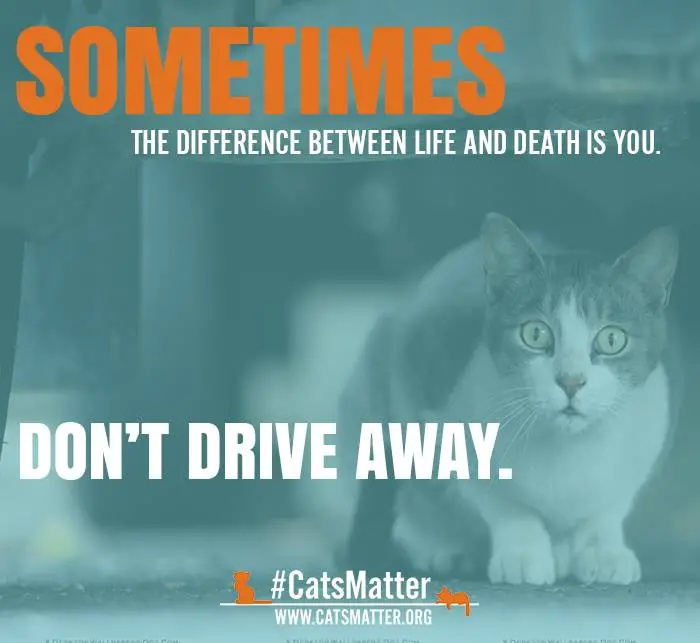Stop your vehicle safely. Check the cat’s condition and call a veterinarian or animal control for help.
Hitting a cat while driving can be a distressing experience. It’s crucial to remain calm and take immediate action to ensure the cat’s well-being. First, stop your vehicle in a safe location to avoid further accidents. Assess the cat’s condition without causing additional stress or injury.
Contact a veterinarian or local animal control for professional assistance. Providing accurate details about the incident can help them offer the best care. Taking responsibility and acting promptly can make a significant difference in the cat’s recovery. Always drive cautiously to prevent such incidents and ensure the safety of all animals.

Credit: www.catsmatter.org
Stay Calm And Safe
First, find a safe spot to pull over. Turn on your hazard lights to alert other drivers. Make sure the area is safe before getting out. Check for traffic before opening your door. Stay calm and collected.
Check On The Cat
First, stop the car safely. Then, look for the cat. It might be scared or hurt. Approach the cat slowly. Loud noises can frighten it more. Check if the cat is breathing. Look for signs of injury. If the cat is bleeding, you need to act fast. Use a cloth to stop the bleeding. If the cat is not moving, it might be in shock. Call a vet immediately.
Move towards the cat gently. Speak in a soft voice. Sudden movements can scare it. If the cat tries to run away, do not chase it. It might come back when it feels safe. If the cat allows, pick it up carefully. Support its body, especially if it seems injured. Place it in a box or a carrier. This will keep the cat calm and safe.
Contact Authorities
Call local animal control right away. They can help the injured cat. Make sure to give them your location. Describe the cat’s condition clearly. They will send help quickly. Stay with the cat until help arrives. This shows you care.
Notify the police if you hit a cat. They can help contact the owner. Give the police details about the accident. This helps them make a report. The report can be useful later. Stay calm and follow their instructions. They are there to help.
Provide Basic First Aid
Use a blanket or towel to cover the cat. This will help keep it warm. The cat may be scared and in pain. Covering it can make it feel safe. Try to move slowly and calmly.
Do not touch the cat with bare hands. It might bite or scratch out of fear. Use gloves if possible. Place the cat in a box or carrier. This will help prevent further injury.
Seek Veterinary Help
Carefully pick up the injured cat. Use a blanket or towel if possible. This helps to keep the cat calm and prevent further injury. Gently place the cat in your car. Drive slowly to the nearest veterinarian.
Tell the vet that you hit a cat with your car. Explain how the accident happened. Share any details you observed about the cat’s condition. This information helps the vet provide better care.
Notify The Owner
First, look for ID tags on the cat’s collar. ID tags usually have the owner’s contact information. Call the number on the tag to inform the owner. If you cannot reach the owner, consider taking the cat to a local veterinarian. Vets can scan for a microchip that holds the owner’s details.
Post about the incident on social media platforms. Use local community groups to reach more people. Include a clear photo of the cat and details about where and when the accident happened. This can help the owner find their pet faster. Social media can be a quick way to spread important information.
Document The Incident
Take photos of the cat and the area. Capture the car’s damage, if any. Photos help prove what happened. Make sure the images are clear. Photographs provide important evidence. Save them on your phone.
Write down details of the incident. Note the time and date. Include the location and weather conditions. Describe the cat’s appearance. Mention any witnesses if there are any. Details help explain the situation later. Keep this information safe.

Credit: www.wikihow.com
Learn From The Experience
Think about your driving habits. Were you going too fast? Were you distracted? Always stay alert while driving, especially in areas with pets. Slow down in neighborhoods and look for any animals. Try to avoid distractions like phones or loud music. This will help you see animals sooner.
Talk to friends about the importance of being careful drivers. Share your story to help others be more aware. This can help save more animals. Use social media to spread awareness. Remind people to watch out for pets on the road. The more people know, the safer it will be for everyone.
Credit: www.quora.com
Frequently Asked Questions
What Happens If I Hit A Cat While Driving?
Stop your vehicle safely. Check on the cat’s condition. Call a vet or animal control for assistance. Report the incident to local authorities if necessary.
Should You Call The Police If You Hit A Cat?
Yes, call the police if you hit a cat. They can help locate the owner and provide assistance.
What To Do If I Drove Over A Cat?
Stop immediately and check the cat’s condition. Contact a local vet or animal rescue for assistance.
Can A Cat Recover From Being Hit By A Car?
Yes, a cat can recover from being hit by a car. Immediate veterinary care is crucial. Recovery depends on the severity of the injuries.
Conclusion
Hitting a cat while driving can be distressing. Stay calm and act responsibly. Ensure the cat receives proper care. Report the incident if necessary. By being mindful and compassionate, you help protect animals and maintain community trust. Always drive cautiously to prevent such accidents in the future.

Hello, this is Frank Swanson, the owner, and operator of Pet Info Hut. I created this website as a way to share my love of pets with the world. I have over 7 years of experience working with animals, and I have a passion for helping people care for their pets. I hope that you find my website useful and informative. Thanks for visiting!
</div>